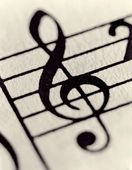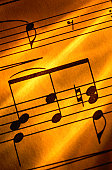
Home > Music Theory > The Piano Grand Staff and Its Clefs
|
||||
The Piano Grand Staff and Its Clefs
Each white key corresponds to a space or line on the grand staff. Each white key you move to the right is one line or space higher on the grand staff than the previous key. Each white key you move to the left is one line or space lower. The grand staff consists of two clefs, the treble clef and bass clef. Each clef consists of five lines and four spaces. The two clefs roughly divide the keyboard of a piano in half. The treble clef is placed on top of the bass clef in the piano grand staff. While the two clefs are written separately, the entire grand staff is one large piece of music notation. Between the two clefs is a line. This line is usually only drawn when a note is actually placed onto it. There are three notes between the top line of the bass clef and bottom line of the treble clef. The line between the two clefs is the line that corresponds to the middle C key on the piano. If you move to the right of the middle C key, you have the notes from the treble clef. To the left of the middle C key are the notes from the bass clef.
For the most part, anything written in the treble clef is most likely going to be played by the right hand. Rhythm parts can appear in the treble clef, so it is not exclusively for melodies. In many of these cases, the rhythm part is going to be split between the top of the bass clef and the bottom of the treble clef. The bass clef of the grand staff almost exclusively is used to play rhythm parts. The human ear does not respond as well to lower frequencies, so lower pitched notes usually have a slightly sluggish quality when used in melody lines. More complicated parts and chords in these frequencies also have a tendency to blend together, removing some of the impact and contrast of the notes. The left hand is used to play the notes on the bass clef in most situations. However, if the melody does dip into the top of the bass clef, it is usually going to be played by the right hand. Understanding the piano grand staff and its clefs is important for a piano player. Virtually every song written for the piano is written in the grand staff. However, the grand staff is fairly intuitive since the layout is so similar to the keyboard. Over time, you should develop a good understanding of the piano grand staff from playing songs from sheet music.
=> http://pianoplayerworld.com/HarmonizeAnyTunes.html
| ||||
|
Although every attempt has been made to make information as accurate as possible, we are not responsible for any errors that may appear.
 The piano grand staff and its clefs is one of the most straight forward examples
of music notation for any instrument. The design of the grand staff is based around the design of a
The piano grand staff and its clefs is one of the most straight forward examples
of music notation for any instrument. The design of the grand staff is based around the design of a 
 The treble clef corresponds to the higher pitched notes of the keyboard. Most of
the melody lines that appear in the piano grand staff and its clefs are going to appear in the treble clef.
Most instruments that play melody lines often use the treble clef for their notation.
The treble clef corresponds to the higher pitched notes of the keyboard. Most of
the melody lines that appear in the piano grand staff and its clefs are going to appear in the treble clef.
Most instruments that play melody lines often use the treble clef for their notation.



